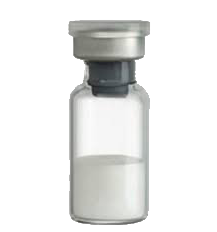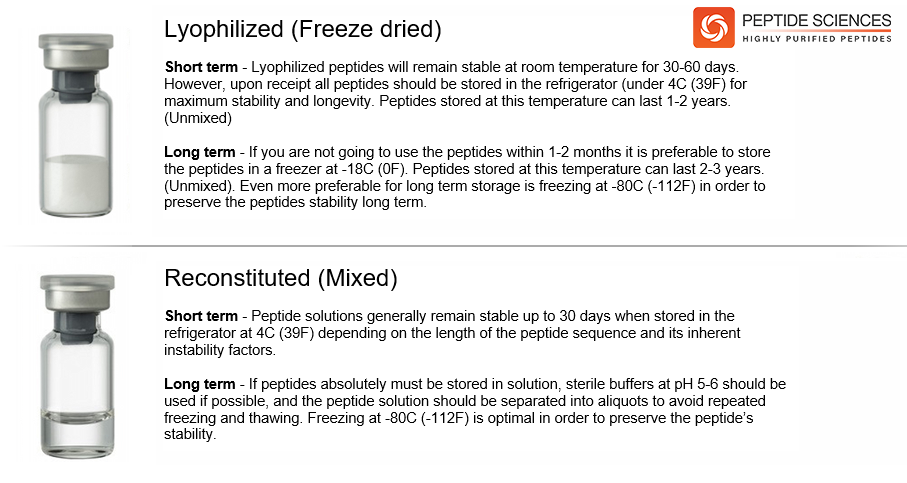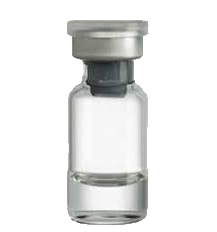Peptide Storage Guidelines: General Tips
To ensure the proper preservation of peptides, adhere to these guidelines:
- Store peptides in a cool, dry, and dark environment.
- Minimize repeated freezing and thawing of peptides.
- Prevent extended exposure to the air.
- Shield peptides from light exposure.
- Avoid long-term storage of peptides in solution.
- Divide peptide samples into aliquots based on your experimental needs
Practices For Storing Peptides
To preserve the integrity of laboratory results, proper storage of peptides is essential. Correct storage practices can maintain peptides for years and guard against contamination, oxidation, and degradation that may render your peptides, and therefore experiments, useless. While some peptides are more susceptible to degradation than others, knowing and implementing the best practices for peptide storage can greatly lengthen their stability and integrity regardless of composition.
Once peptides have been received, it is imperative that they are kept cold and away from light. If the peptides will be used immediately, or in the next several days, weeks or months, short-term refrigeration under 4C (39F) is generally acceptable. Lyophilized peptides are usually stable at room temperatures for several weeks or more, so if they will be utilized within weeks or months such storage is typically adequate.
However, for longer term storage (several months to years) it is more preferable to store peptides in a freezer at -80C (-112F). When storing peptides for months or even years, freezing is optimal in order to preserve the peptide’s stability.
Additionally, it is important to avoid repeated freeze-thaw cycles. This can increase the peptide’s susceptibility to degradation. Also, frost-free freezers should be avoided to store peptides, as temperatures can fluctuate widely during defrosting cycles.
 Lyophilized (Freeze dried)
Lyophilized (Freeze dried)

Preventing Contamination and Moisture
It is of utmost importance to shield peptides from both air and moisture contamination. Moisture contamination is particularly prone to occur when a peptide is used immediately after removal from the freezer. To avert the absorption of moisture from the surrounding air onto the cold peptide’s surface or inside its container, it is crucial to allow the peptide to reach room temperature before opening it.
Furthermore, minimizing a peptide’s exposure to the air is equally critical. Peptide containers should be kept closed whenever possible. Once the required amount of peptide has been withdrawn, resealing the container in an atmosphere of dry, inert gas (such as nitrogen or argon) significantly reduces the risk of oxidation for any remaining peptide. Peptides containing the amino acids C (cysteine), M (methionine), and W (tryptophan) are particularly susceptible to oxidation when exposed to air.
To mitigate the impact of frequent thawing and refreezing, as well as exposure to air, many researchers prefer a practical approach. They determine the required amount of peptide for each experiment and aliquot this amount into separate vials as needed. This precautionary measure effectively safeguards against peptide degradation and ensures the peptide’s long-term stability.
Storing Peptides In Solution
The stability of peptide solutions is notably shorter compared to lyophilized peptides, and peptides in solution are susceptible to bacterial degradation. Particularly, peptides containing amino acids like Cys, Met, Trp, Asp, Gln, and having N-terminal Glu in their sequences exhibit shorter shelf lives when in solution.
However, in cases where peptides must be stored in solution, it’s advisable to use sterile buffers with a pH range of 5-6. Furthermore, dividing the peptide solution into aliquots helps prevent the need for repeated freezing and thawing, which can compromise stability. Generally, peptide solutions remain stable for approximately 30 days when refrigerated at 4°C (39°F). For peptides with inherent instability, it’s recommended to keep them frozen when not in use.
Storing Peptides In Containers
Containers for storing peptides should meet specific criteria to ensure the integrity of the peptides. These containers should be:
- Completely clean, clear, and structurally sound.
- Chemically resistant to prevent any interaction with the peptides.
- Appropriately sized to accommodate the quantity of peptide.
- Glass and plastic vials are commonly used for peptide storage. Plastic vials come in variations like polystyrene and polypropylene. Polystyrene vials are typically clear but lack chemical resistance, whereas polypropylene vials are generally translucent but offer chemical resistance.
While high-quality glass vials possess all the desired characteristics for peptide storage, peptides are sometimes initially shipped in plastic vials to minimize the risk of breakage during transit. Nonetheless, if needed, peptides can be easily transferred from plastic to glass containers or vice versa.

